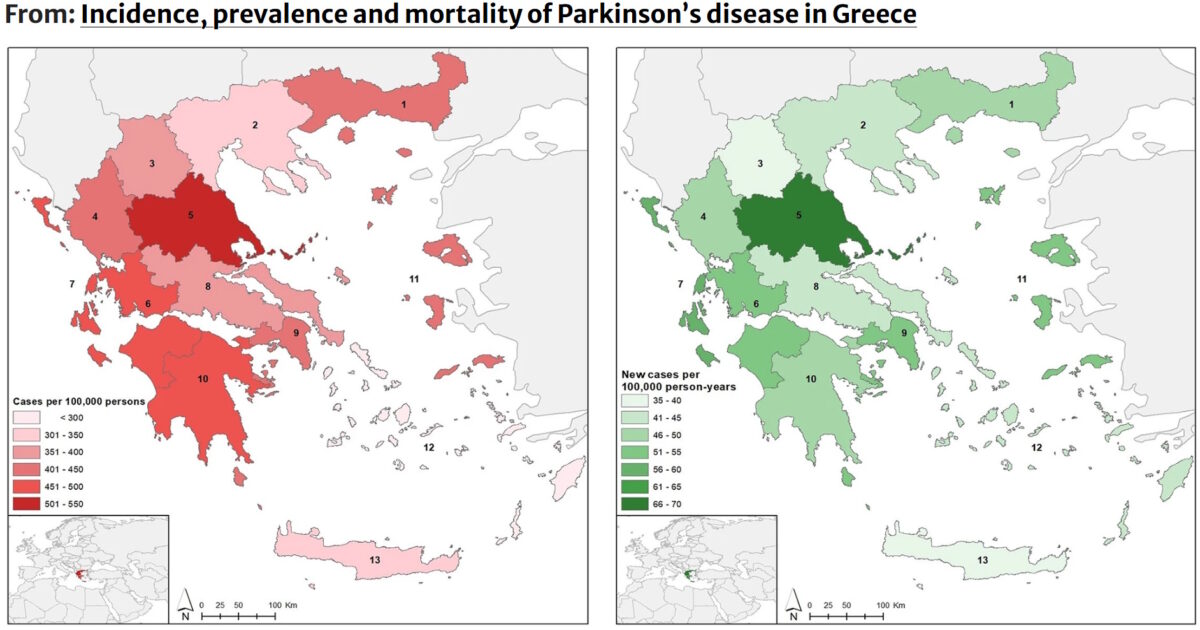His disease Parkinson It is hitting more and more Greeks, greatly affecting their daily lives.
Parkinson’s disease is not a rare neurological disease that affects few. A new study by Greek scientists, published in the Neurological Sciences scientific journal, in July 2025, brings to light the real size of the problem in our country for the first time, utilizing EOPYY electronic prescription data through the HIDA system.
According to a study by the University of Crete, 70,000 citizens suffer from the disease in our country, and 23,000 new diagnoses are recorded each year. Also, 37,000 deaths have been recorded in the last five years.
The research was based on the analysis of 1,808,000 anti -Corinsaic drug recipes between 1/1/2020 to 1/1/2025 and is particularly important because it brightens the actual size of the disease for the first time. To date, the figures have been fragmented or based on estimates. The new data, therefore, reveals that Parkinson is a large mass of the Greek population and therefore has significant consequences on the health system.
An important element of the study is also how Thessaly records almost twice the new incidents per year compared to areas such as Crete and the South Aegean, which has not yet been sufficiently explained by scientists. However, it provides important information on which needs to be enhanced by health care.
Parkinson’s disease: The inequalities
The study shows that the prevalence of Parkinson’s disease in Greece is 400 cases per 100,000 population, that is about 0.4% of the general population and 2.8% in people over 80 years.
The annual incidence is 48 new incidents per 100,000 people a year (man), while men are more commonly diagnosed in every age group.
A statistical paradox, however, is that women have a total higher prevalence rate, explained by their longer survival.
Mortality data are also revealing, as patients with Parkinson’s disease have a significantly increased risk of death compared to the general population.
Specifically:
In the age group of 70-79 years, patients have a 6.6 times higher risk of death than their peers without the disease.
At over 80, the risk is about twice as much as the general population.
The “map” of the incidence of the disease
Inequalities, however, are not only limited to gender, but also extend to geographical distribution.
In Thessaly, new cases of patients with Parkinson’s disease per year are almost twice as compared to areas such as the South Aegean or Crete.
Following Thessaly, followed: The Region of Eastern Macedonia – Thrace, the Peloponnese and Western Central Greece.
More specifically:
In Crete, the disease occurs less rarely, with about 35 new cases per 100,000 inhabitants each year.
In Thessaly, the impact is greater, with about 69 new incidents per 100,000 inhabitants each year.
See the relevant map, which records the prevalence and impact of Parkinson’s disease by geographical apartment:

The importance of the study
This recording gives the Greek health system the opportunity to have a clear picture of how many people live with Parkinson’s and how they are geographically distributed. The study of this study is not only academic but also purely practical, as the life expectancy increases, the number of Parkinson’s patients grows.
“Our results provide powerful epidemiological elements that can guide the strategic distribution of health system resources and social resources for Parkinson’s disease in Greece,” the study authors say in their conclusions and add how their research sets the foundations for further detailed epidemic fluctuations of the disease. “
Finally, they point out how the use of administrative data – such as electronic prescription, which has now begun to be used to record and create registries of many diseases – offers a reliable picture of real clinical practice and can be a guide to health policies.
The epidemic of Parkinson’s disease
Parkinson’s disease is a progressive, age -old neurodegenerative disorder that manifests both motor and non -motor symptoms.
Although it is the second most common neurodegenerative disease worldwide after dementia, recent data show that it has the fastest increasing incidence and the highest related level of disability between neurodegenerative diseases.
Unfortunately, there are only symptomatic treatments available, as there are no treatments that modify the course of the disease or prevent it.
Given the worldwide aging population and the growing weight of the disease for patients, their carers, families and healthcare systems, epidemiological research is critical for the proper distribution of resources, as the authors say.
At the same time, epidemiological data can play a decisive role in recognizing important genetic and environmental factors that contribute to the pathogenesis of the disease, which may have variations by geographical area.
Global estimates of the epidemiological burden of Parkinson’s disease are often based on incomplete data, while high quality epidemiological studies per country are mainly available in the most developed countries.
Source Iatropedia.gr
